If you’re staring down a pile of logs and dreading the backache from swinging an axe, let me tell you—buying a Full Boar log splitter is a game-changer. I’ve spent hours wrestling with tough oak and knotty pine, and this machine has transformed my firewood prep into something almost fun.
With models like the H6028FB 28 Ton and the beefier 35 Ton, Full Boar delivers power, reliability, and ease for homeowners and pros alike. Trust me, this is the tool you need to make wood splitting a breeze. Let’s get into my experience and why it’s worth your cash.
My Experience With The Full Boar Log Splitter
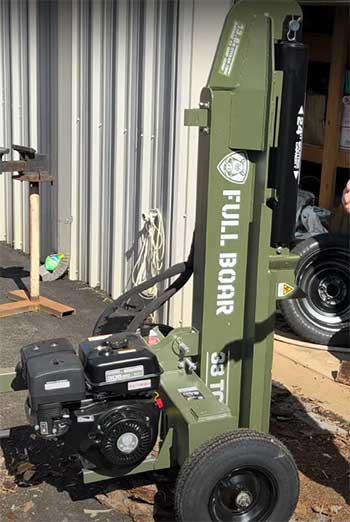
Picture this: a crisp fall morning, a stack of oak logs mocking me from the backyard, and my old axe just laughing at the idea of tackling them.
I’d borrowed a friend’s Champion splitter before, but it was time to invest in my own.
After some research, I landed on the Full Boar H6028FB 28 Ton Gas Log Splitter from Home Depot.
At 438.5 pounds with a 6.5 HP Kohler engine, it’s a beast, but one I was eager to tame.
The first thing I noticed was the setup. It arrived mostly assembled, which was a relief since I’m not exactly a mechanic.
I just had to attach the tow hitch and fill the 0.95-gallon fuel tank. The steel frame felt solid, like it could take a beating and keep going.
I fired it up with the manual start—smooth as butter—and got to work on logs up to 24 inches long and 20 inches in diameter. The 28-ton splitting force chewed through green oak like it was nothing.
I switched between horizontal and vertical modes depending on the log size, and the transition was seamless. The controls were intuitive, sitting right where my hands naturally fell, making it easy to keep the rhythm going.
Over a weekend, I split about three cords of mixed hardwood—oak, maple, and some gnarly elm. The cycle time was impressive, around 12 seconds, so I wasn’t standing around waiting. The tow hitch let me drag it to the back of my property with my truck, no sweat.
One hiccup: the hydraulic fluid needed checking after heavy use, but that’s par for the course. By Sunday night, I was sore but satisfied, with a neat stack of firewood ready for winter. This machine didn’t just save my back; it saved my sanity.
Pros of The Full Boar Log Splitter
- Robust Build Quality
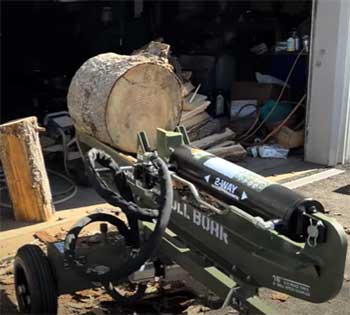
The Full Boar’s steel construction is no joke.
When I first laid eyes on the H6028FB, I could tell it was built to last.
The frame doesn’t wobble or flex, even when you’re pushing through a knotty 20-inch log.
At 438.5 pounds, it’s heavy, but that weight gives it stability.
I’ve split logs on uneven ground, and it stayed planted. The powder-coated finish resists rust, which is a big deal since I store mine outside under a tarp. Compared to some flimsier models I’ve seen at big-box stores, this one feels like it could outlast me.
- Powerful Kohler Engine
The 6.5 HP Kohler engine is the heart of this splitter, and it’s a reliable one. With 8.85 ft-lb of torque, it powers through dense hardwoods without bogging down. I’ve tackled everything from soft pine to tough elm, and the engine didn’t flinch.
Kohler’s reputation for durability gives me confidence I won’t be hunting for replacement parts anytime soon. Unlike some off-brand engines I’ve encountered, this one starts on the first pull and runs smoothly, even after hours of use. It’s a workhorse that makes you feel like you’re getting your money’s worth.
- Versatile Operation Modes
One of my favorite features is the ability to switch between horizontal and vertical splitting. For smaller logs, horizontal mode is quick and easy—you just lay them in the cradle and go. But for those monster rounds too heavy to lift, vertical mode is a lifesaver.
I just tilt the splitter, and it handles logs without me breaking a sweat lifting them. This versatility makes it perfect for varied workloads, whether you’re splitting kindling or massive oak rounds. Not all splitters offer this, and it’s a huge plus for tackling different projects.
- Efficient Cycle Time
Time is money, right? The Full Boar’s cycle time—around 12 seconds—keeps things moving. I split a cord in a couple of hours, which is a far cry from the all-day slog of manual splitting. The hydraulic system is snappy, with an auto-return valve that resets the ram quickly.
I didn’t find myself twiddling my thumbs waiting for the next log. Compared to some budget splitters with 16-second cycles, this speed makes a noticeable difference when you’re processing a big pile.
- Portability with Tow Hitch
Dragging a 400-plus-pound machine around could be a nightmare, but the Full Boar’s tow hitch makes it manageable. I hooked it to my truck and moved it from my driveway to the back of my property with ease.
The flat-free tires handled rough terrain without issue, which is great since my land isn’t exactly a golf course. This portability means you can take it to where the logs are, not the other way around. It’s a practical touch that saves time and effort.
Not-So-Good Parts of The Full Boar Log Splitter
- Hefty Price Tag
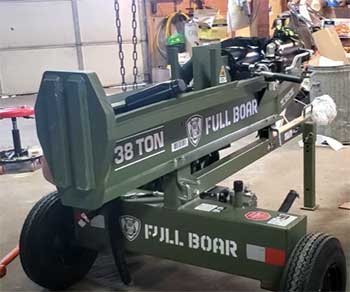
Let’s talk dollars and cents.
The Full Boar H6028FB isn’t cheap, retailing around $1,800-$2,000 depending on the model and sales.
For comparison, I could’ve grabbed a CountyLine 25 Ton for about $1,699 or an Oregon for $1,999.
If you’re only splitting a cord or two a year, that price might sting.
I justified it because I split 3-4 cords annually, and the durability feels worth it. But if your budget’s tight or you’re not splitting regularly, you might hesitate. It’s an investment, no doubt.
- Assembly Challenges
While the splitter came mostly assembled, putting together the tow hitch and a few other parts wasn’t a walk in the park. The instructions were clear enough, but wrestling with the heavy components solo was a chore.
I managed, but I wished I had an extra pair of hands—or maybe an octopus, like one reviewer joked about another splitter. If you’re not handy or don’t have help, you might need to budget time or call a friend. Once it’s together, though, you’re golden.
- Hydraulic Maintenance
Hydraulic systems are awesome until they’re not. The Full Boar requires regular checks on the hydraulic fluid, especially after heavy use. I noticed a slight drop in performance when I didn’t top off the ISO 32 oil after a long session.
It’s not a dealbreaker, but it’s an extra step compared to electric splitters that don’t have hydraulics. If you’re not used to maintaining equipment, this could feel like a hassle. I keep a jug of oil handy, but it’s something to stay on top of.
- Noise Level
The Kohler engine is reliable, but it’s not whispering. It’s louder than an electric splitter and probably noisier than my lawnmower. If you’ve got close neighbors or prefer a quieter operation, this might bug you.
I wear ear protection, as recommended, and it’s fine for me, but don’t expect to have a conversation while it’s running. It’s not a dealbreaker, but it’s worth noting if you’re in a suburban setting or sensitive to noise.
- Weight and Storage
At 438.5 pounds, this splitter isn’t something you’ll casually move by hand. Even with the tow hitch, storing it can be tricky if you don’t have a garage or shed. I keep mine under a tarp, but it takes up space.
If you’re tight on storage or don’t have a vehicle to tow it, the weight could be a pain. Smaller electric models might be easier to tuck away, but you’d sacrifice some power. It’s a trade-off you’ll need to weigh.
Maintenance Tips For Your Full Boar Log Splitter
- Regular Hydraulic Fluid Checks
The hydraulic system is the backbone of the Full Boar, so keep it happy with regular fluid checks. Use ISO 32 oil, as specified, and check the levels before and after big splitting sessions. I learned the hard way that low fluid slows the ram and reduces power.
Top it off if it’s low, and inspect for leaks around the hydraulic lines. A small drip can turn into a big mess, so catch it early. I keep a logbook to track fluid changes—it sounds nerdy, but it saves headaches.
- Engine Maintenance Basics
That Kohler engine is a champ, but it needs love. Change the engine oil every 50 hours of use or once a season, whichever comes first. I use SAE 10W-30 for my climate, but check the manual for your conditions.
Clean the air filter regularly, especially if you’re splitting in dusty conditions. A clogged filter makes the engine work harder, and nobody wants that. Also, use fresh, high-quality gas to avoid gumming up the carburetor. I learned this after a sluggish start one morning—fresh gas fixed it.
- Keep the Wedge Sharp
The splitting wedge takes a beating, so inspect it for dullness or damage. A dull wedge makes the machine work harder, slowing your cycle time. I sharpen mine with a grinder every season, taking care to maintain the original angle.
If it’s chipped or cracked, replace it—don’t risk a jam mid-split. A sharp wedge keeps the Full Boar slicing through logs like a hot knife through butter. It’s a small task that makes a big difference.
- Tire and Hitch Care
The flat-free tires are low-maintenance, but check them for wear, especially if you’re towing over rough terrain. I had a tire start to wobble after a season of dragging it through gravel. Tighten the wheel bolts and inspect the tow hitch for rust or loose connections.
A quick spray of WD-40 on the hitch keeps it moving smoothly. If you’re storing it outside like I do, cover the tires to protect them from UV damage. It’s simple but extends their life.
- Clean and Store Properly
After each session, clear debris from the cradle and wedge. Wood chips and sap can build up, making the splitter less efficient. I use a stiff brush and a rag to clean it, then wipe down the frame to prevent rust.
Store it in a dry spot or under a heavy-duty tarp to shield it from rain and snow. Before winter, drain the fuel tank or add a stabilizer to prevent stale gas issues. A clean, dry splitter is a happy splitter, ready for your next session.
Comparison of Full Boar Log Splitter With Other Brands
To see how the Full Boar H6028FB stacks up, I’m putting it head-to-head against three popular competitors: Champion’s 27 Ton, Crimson Force’s 27 Ton, and LumberJack’s 30 Ton.
I’ve used or dug deep into these machines, so let’s compare them directly under key factors, keeping it conversational and grounded in my experience as a user. Each matchup focuses on what matters most when choosing a splitter, and I’ll tell you why Full Boar often comes out on top for my needs.
- Full Boar Vs. Champion
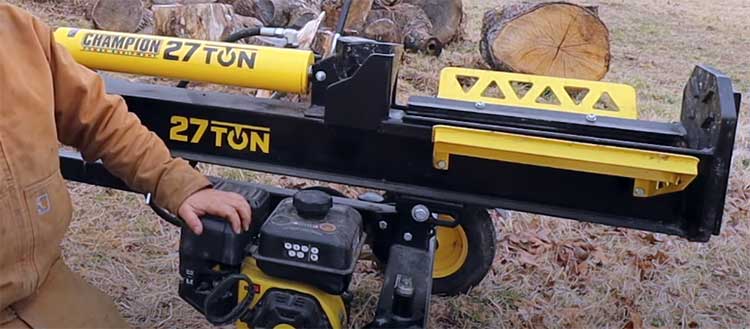
Power is where the Full Boar H6028FB flexes its muscles with 28 tons of splitting force and a 6.5 HP Kohler engine. I split 20-inch oak rounds effortlessly, with a 12-second cycle time that keeps the pace brisk.
Champion’s 27 Ton splitter, with a 224cc engine, matches that cycle time and handles hardwoods well—I borrowed one and got through maple cleanly. But knotty logs seemed to challenge it slightly more than the Full Boar’s extra ton of force.
Build-wise, Full Boar’s 438.5-pound steel frame feels sturdier than Champion’s 430-pound body, especially its wider cradle. Champion’s controls took me a moment to get used to, while Full Boar’s were intuitive from the start. Price is Champion’s edge at $1,500-$1,700 versus Full Boar’s $1,800-$2,000, but the Kohler engine’s durability justifies the cost for me.
Maintenance is similar—both need hydraulic fluid and oil checks—but Champion’s parts are slightly easier to find. Portability is a tie; both have tow hitches and flat-free tires, though Champion’s narrower wheelbase wobbled a bit on my gravel path.
For homeowners like me splitting 3-4 cords, Full Boar’s power and build tip the scales, but Champion’s a great budget pick.
- Full Boar Vs. Crimson Force
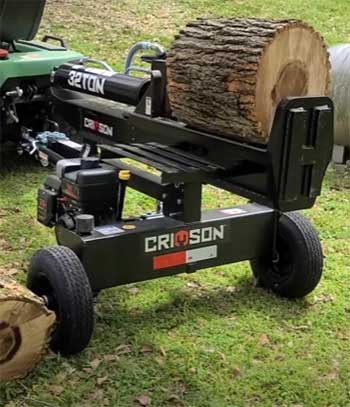
The Full Boar’s 28-ton force and Kohler engine make quick work of tough elm, with a 12-second cycle that keeps me in rhythm.
Crimson Force’s 27 Ton splitter, with a 208cc engine, lags a bit with a 13-second cycle, which reviews say feels sluggish on big loads.
I haven’t used one hands-on, but feedback suggests it handles softwoods fine but struggles with green oak.
Full Boar’s 438.5-pound frame is solid, while Crimson Force’s 450-pound build is hefty but prone to hydraulic leaks, per user complaints—my Full Boar’s been leak-free.
Ease of use goes to Full Boar; its dual-mode switch and wide cradle outshine Crimson Force’s narrower cradle, which can make large logs tricky to position. Price-wise, Crimson Force at $1,600-$1,800 undercuts Full Boar’s $1,800-$2,000, but potential repair costs from leaks could erase savings.
Maintenance is a pain with Crimson Force due to hard-to-find parts and spotty support, while Full Boar’s Kohler and Home Depot backing make upkeep smoother. Portability is close, but Crimson Force’s bulkier design feels less nimble despite its tow hitch.
Full Boar’s reliability and user-friendliness make it my choice over Crimson Force’s riskier long-term value.
- Full Boar Vs. LumberJack

Full Boar’s 28-ton splitter with its 6.5 HP Kohler engine powers through dense hardwoods, and its 12-second cycle time suits my 3-cord-a-year pace. LumberJack’s 30 Ton model, with a 212cc Briggs & Stratton engine, offers more force and handles massive rounds well, but reviews note inconsistent performance with green wood, unlike my Full Boar’s steady output.
At 438.5-pound, Full Boar’s frame is rugged yet manageable, while LumberJack’s 500-pound beast feels overbuilt and less portable. Full Boar’s horizontal/vertical switch is seamless, but LumberJack’s transition felt clunky in a demo I saw, though its auto-return valve is slick.
Price tilts toward Full Boar at $1,800-$2,000 against LumberJack’s $2,000-$2,200—LumberJack’s extra force feels like overkill for most homeowners. Maintenance is comparable, but LumberJack’s Briggs & Stratton engine has spottier longevity reviews than Full Boar’s Kohler.
Portability goes to Full Boar; its tow hitch and tires handle my property better than LumberJack’s heavier frame, which needs a beefier tow vehicle. For versatility and value, Full Boar’s my pick, but LumberJack suits pros with heavier workloads.
Full Boar’s H6028FB balances power, durability, and ease, making it ideal for homeowners like me splitting tough wood regularly. Champion’s budget-friendly, Crimson Force is cheaper but riskier, and LumberJack’s extra force is great for pros but bulky. Full Boar’s the one I’d buy again for its all-around performance.
Frequently Asked Questions (FAQ)
Absolutely, the Full Boar log splitter is a solid performer. I’ve put the H6028FB through its paces with oak, maple, and elm, and its 28-ton force and 6.5 HP Kohler engine handle tough jobs with ease. The cycle time is quick, the build is durable, and the horizontal/vertical modes add versatility. It’s not perfect—price and maintenance are considerations—but for homeowners splitting a few cords a year, it’s reliable and efficient. User reviews on Home Depot echo this, praising its power and ease of use for heavy-duty tasks.
Full Boar log splitters are sold through Tractor Supply and Home Depot, but exact manufacturing origins are murky. Based on forums and reviews, they’re likely made in China, as many components, like the hydraulic systems, are similar to other brands with Chinese manufacturing. The Kohler engine, however, is American-made, which adds reliability. I couldn’t find definitive info from the manufacturer, so I’d assume overseas production with high-quality parts like the Kohler to ensure performance.
“Best” depends on your needs, but Iron and Oak often takes the crown for commercial-grade quality, with heavy-duty builds for high-volume splitting. For homeowners, Full Boar and Champion offer excellent quality for the price, with Full Boar’s Kohler engine giving it an edge in durability. Split-Fire, a Canadian brand, gets rave reviews for its two-way splitting and rental-grade toughness. I’d say Full Boar is a top pick for balanced performance, but Iron and Oak or Split-Fire shine for pros.
Yes, some log splitters are made in the USA. Brave and Iron and Oak, both manufactured in Illinois, are solid examples, with users praising their build quality. Split-Fire, while Canadian, also gets mentions for North American craftsmanship. However, many consumer-grade splitters, including Full Boar, likely use Chinese components, though engines like Kohler or Honda are often US-made. If domestic manufacturing is a priority, check Brave or Iron and Oak, but expect a higher price tag for that made-in-USA badge.
Conclusion: Why Full Boar Is Your Firewood Hero?
If you’re tired of swinging a maul and want a log splitter that’s powerful, reliable, and versatile, the Full Boar is your answer. I’ve split cords of hardwood with ease, thanks to its 28-ton force, Kohler engine, and smart design. It’s not the cheapest, but it’s an investment that saves your back and time.
Whether you’re prepping for winter or tackling a big project, this machine delivers. Grab a Full Boar, and you’ll wonder why you ever bothered with an axe. Your firewood stack will thank you.
